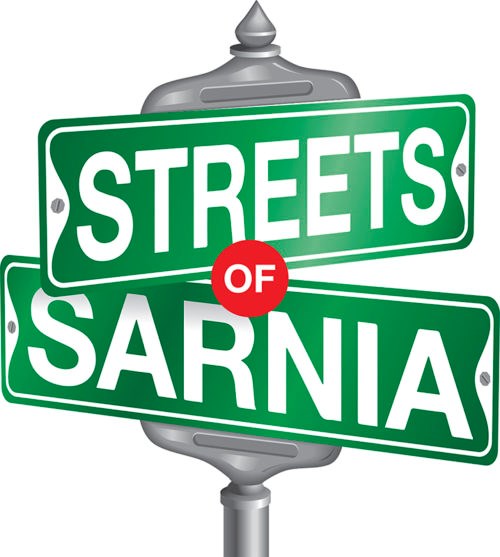The following is an excerpt from The Streets of Sarnia Project, a volunteer project by local researchers Tom St. Amand and Randy Evans, providing explanations for all but a handful of Sarnia’s 700 street names.
By Randy Evans & Tom St. Amand
One of the many simple (and free) pleasures that Sarnia-Lambton offers its residents and tourists alike is the year round tour of Canatara Park via picturesque Lake Chipican Drive—whether it be by car, by bike or on foot.
Registered Plan 268 of the White Subdivision (1932) shows that the area Lake Chipican Drive encompasses was part of Lot 20 of the Front or Ninth Concession. One of Sarnia's most popular roads was not built until 1938, began approximately 30 meters north of today's main entrance off Christina Street (then known as Woodrowe Road) and was given the rather unimaginative name of Park Road.
At an October 1945 meeting of the Parks Board, members decided to rename it Lake Chipican Drive. And by 1953, the east entrance to Canatara Park was moved south to where it is today. This followed the installation in 1951 of the pillars which still guard the main entrance to the park. Donated to the city in 1927 by the I.O.D.E. (Imperial Order of the Daughters of the Empire), the pillars had stood for over two decades at the corner of East St. and London Road.
Why Lake Chipican Drive? Well, the name had history on its side. The body of water known as Lake Chipican was mentioned in print over 170 years ago in W. H. Smith's reference book entitled Smith's Canadian Gazetteer, Canada West 1846. The gazetteer, the first of its kind for Ontario, identified a city, a town, a village, or a hamlet by its name and its location and also provided any details about the place as they were known at the time. In describing the area around Port Sarnia, Smith mentioned that “Lake Chipican, a small lake about six acres in extent, is separated from Lake Huron by a ridge of high land: it is two miles north from Port Sarnia.”
While certain residents called it “Lake Chipican” in 1846, some also referred it as “Seward's Pond” at that time. In his wonderful book, History of Sarnia Township 1829 - 1990, Dean Hodgson mentions that sometime in the early 1840s New Yorker John Slocum, the first 162 commercial fisherman in Sarnia Township, and his employee, Connecticut born Henry Seward, established a successful fishery on the St. Clair River in Point Edward.
According to longtime Lake Chipican Drive resident and local researcher, Jack Fraser, Seward lived in a house in the northwest corner of Lake Chipican from approximately 1840 – 1860. For many years, people referred to the adjacent body of water as “Seward's Pond” and the road that became Woodrowe Road and later Christina Street was originally known as Seward Road.
Lake Chipican was also known until the 1950s as “Little Lake” for obvious reasons. At normal water levels, the lake spans approximately 15 acres and has a maximum depth of 10 feet. It’s a dewdrop compared to Lake Huron whose over 14 million acres and maximum depth of 750 feet make it world famous. Local newspaper articles until the 1950s referred to the small body of water in Canatara Park as both “Lake Chipican” and “Little Lake”. Perhaps, as Fraser suggests, the naming is “a generational thing. Most people today just call it Lake Chipican because it’s what they’ve heard.”
Evidence reveals that historically and currently most residents refer to the familiar lake south of Lake Huron as “Lake Chipican.” But its name origin remains a bit of a mystery. The answer might lie with what it was—and still is—called by some people: “Lake of the Root” or “Lake of Roots”.
Certain legends have grown about the Lake Chipican area. First Nations people considered the waters of this small lake to be sacred and their name for it was "Lake of the Root" or “Lake of Roots.” The roots of the plants growing in and around the lake were used to make medicine. Historically, it is believed that Ojibway Medicine Men gathered the roots required by them from this special lake and that no women were allowed to approach the shores because the lake was considered sacred.
Chippewa native, Philip George, was in his 87th year (born in 1862) when he disclosed the origin of the word Chipican and, specifically, Lake Chipican from this story he had heard from his ancestors.
Lake Chipican was named for a native girl called in Ojibway, Chip-Kan, who would have been born around 1797. In English, this word would translate to “root” and the translation for Lake 163 Chipican is “Lake of the Root” or “Lake of Roots”. The local connection is that Chip-Kan was the full sister to Eliza Maccoose, who was the wife of Chief Joshua Wawanosh.
Why Chief Wawanosh decided to name this lake after his sister-in-in law is something that Mr. George does not know. Nor does he have any idea how Chief Wawanosh’s sister-in-law would have gotten the name “Chip-Kan” (or Root) for the choosing of a native name is highly personal to the individual.
(Canatara Park; “Canatara Tulips”; Chenier-Cullen; Fraser, Jack; George, Philip; “Hodgson, Dean, History of Sarnia Township, page 34; “How Deep”; “Largest Lakes”; Smith, W.H.)
